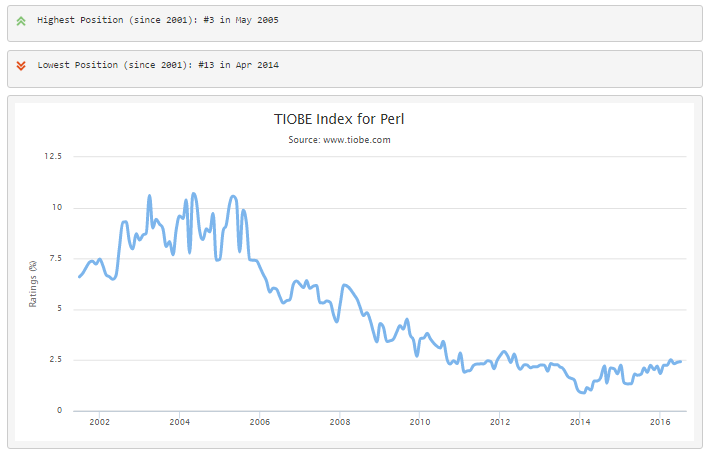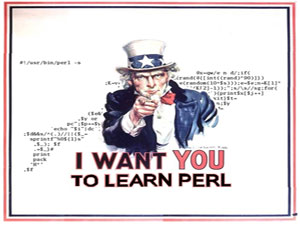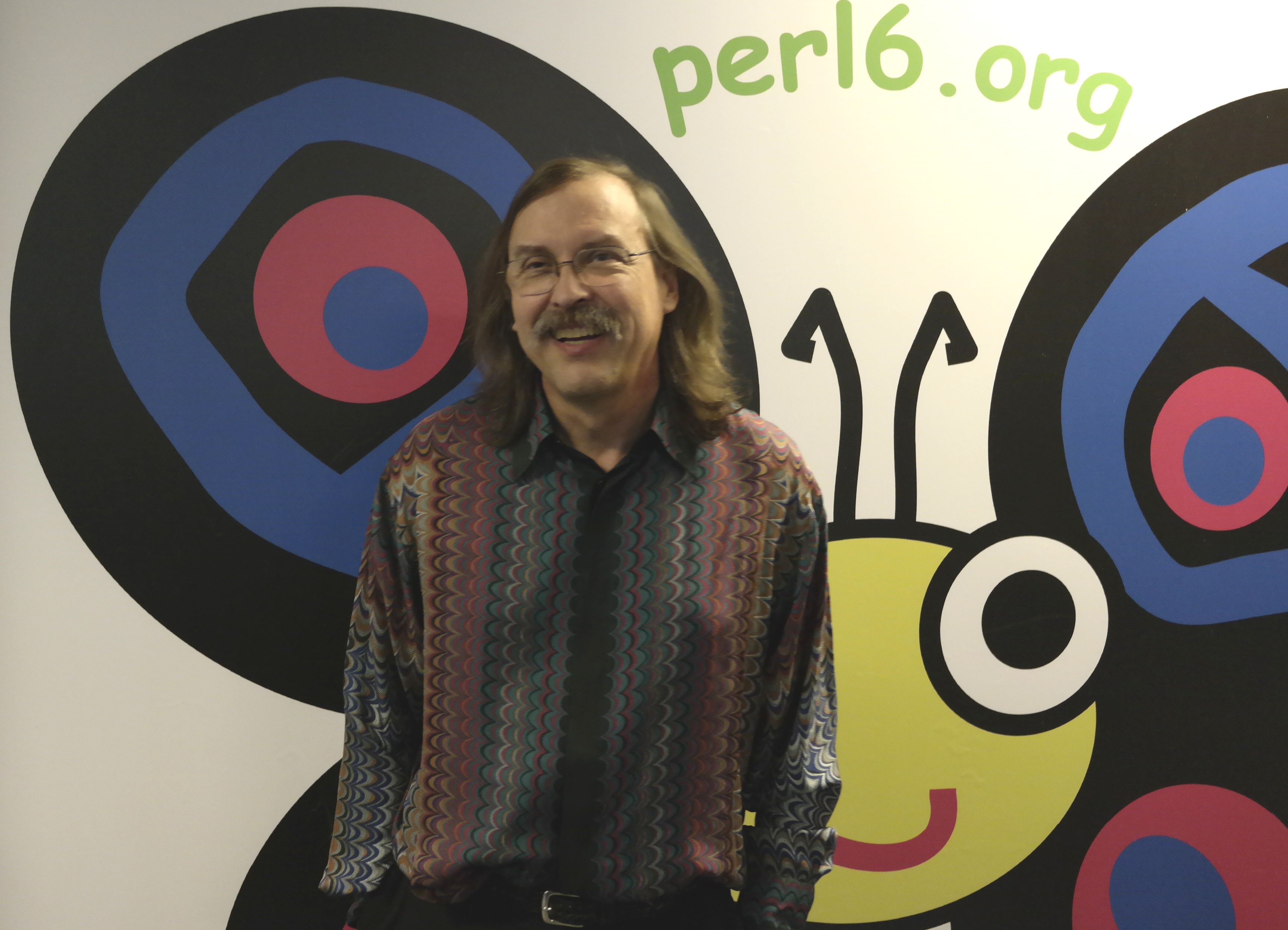A person. The creator of Perl, Larry Wall - "the generous lifelong dictator"

Today on “Habré” there was already a post dedicated to the birthday of the creator of the Perl language. Here I would like to talk more about the biography and views of Larry Wall, about his motivation to create a programming language, as well as to cite several excerpts from a recent interview.
Larry Wall is an American programmer, linguist and creator of the Perl programming language, one of the leaders of the movement for free access to software.
')
The first steps
Larry was born on September 27, 1954 in Los Angeles to a family of hereditary Protestant pastors. The boy grew up in the small town of Brementon in Washington State and dreamed of becoming a church minister. This desire did not come true, but Larry himself is considered one of the few religious figures in the world of eminent programmers.
He studied at Larry Wall in a Christian educational institution - Seattle Pacific University. In 1976, he received a bachelor's degree in linguistics. During the training, and the makings of the future author of Perl. For three years, as a student, Larry worked at the university computer center.

After graduation, Larry and his wife (Gloria Born) worked as Bible translators, and then both went to graduate school at the University of California at Berkeley. The young family of linguists still saw their future in the church arena.
But the turning point came, and Larry’s work at the computer center was one of the reasons that, despite his linguistic education, he decided to take up computer technology. Larry considered this a more promising occupation.
He went to work at Unisys and NASA's Jet Propulsion Laboratory (JPL). Free time the future guru was engaged in the development of programs for UNIX.
Perl: not for glory, not for payment
In 1987, Larry Wall created the Perl programming language. He then worked as a system programmer at the American company Unisys. The goals that Larry pursued when developing a new programming language are reflected in its name - PERL, which later became deciphered as the Practical Extraction and Report Language, that is, “a practical language for data extraction and reporting”.

From 1995 to 2002, Larry Wall worked for O'Reilly & Associates, the publisher of his books. Care was associated with a Perl Foundation grant.
In 2004, Larry took the post of senior researcher, and in fact the “chief programmer” at NetLabs.
Now Larry Wall continues to develop the Perl language under the patronage of O'Reilly and lives with his wife, a writer and four children in the town of Mountain View in California.
The purpose of the author of the Perl language has never been to get money. On the contrary, he made a significant contribution to the “culture” of free distribution of programs with their source codes. The new programming language Wall developed in order to solve the problems that he, as a programmer, himself had encountered during the working day.
When the first version of the language was published, Larry Wall provided open access to the source code of the program itself. Anyone can download Perl for free, regardless of whether they need it to improve their own page or to create a multi-million Internet project.
Despite the fact that in the Unix operating system, for which Perl was created, there were already numerous and diverse means for processing textual information (awk, csh, grep, sed, and others), a huge number of system administrators and programmers fell in love. It was easy to learn and use: the syntax was similar to C, there was no need to pre-compile the Perl program, the source code was easy to modify. And most importantly, it was a really very practical language: most everyday tasks were easily solved with its help, from the simplest to the most complex.
 Actively using Perl, programmers from different countries sent Larry Wall suggestions to add new features or improve existing ones. Gradually, Perl has evolved from a Unix word processing tool into a powerful universal programming system. In the mid-1990s, as the Internet developed, Perl became a favorite tool for webmasters to create dynamic websites and Internet programming.
Actively using Perl, programmers from different countries sent Larry Wall suggestions to add new features or improve existing ones. Gradually, Perl has evolved from a Unix word processing tool into a powerful universal programming system. In the mid-1990s, as the Internet developed, Perl became a favorite tool for webmasters to create dynamic websites and Internet programming.Thanks to the Perl language, Yahoo started, with its help Amazon and millions of other sites were created.
December 24, 2015, the official blog on Perl 6 development news has a congratulatory post. The developers congratulated everyone on the upcoming Catholic Christmas, and with the fact that the so long expected maturity of the language finally took place. In fact, the language is ready for use in work projects, and the developers promise nothing more to change significantly.
Almost 29 years have passed since the release of the first version of Perl, more than 20 years since the release of the most popular version of Perl 5 at this time. As Larry Wall jokes, the creator of the language and the leader of its development, the 6th version may sometime replace the 5th version - in about 40 years.
The version of Perl 6 was announced more than 10 years ago - on Amazon you can also buy a book about this “soon leaving” language published in 2004. And although some argue that 6-ka differs from 5-th by nothing more than C ++ from C, after all, the ideology in Perl 6 has evolved enough to call it a more modern language.
Larry Wall hopes that teachers at institutes will be able, finally, using the same language, to teach students different programming styles - functional, procedural and object.

Perl 6 logo chosen butterfly. As (half in jokingly) explained Wall at a conference in October of this year, this was done specifically to make the language attractive for 7-year-old girls.
Any questions?
Recently, Larry Wall was interviewed by Slashdot. Here are some excerpts from the conversation.
What kind of computer do you use? What applications do you prefer?
For a year or two, I have been using the Lenovo X1 Carbon2 with a 4-core processor. With the exception of the disgusting keyboard layout and the almost useless capacitive touch strip, it is almost perfect for developing, communicating and giving presentations. It is running the Linux Mint operating system.
As for the editors ... I use different. I do not have any specific preferences.
On the computer, I use the Firefox browser, and on my ancient Google Phone there is a Chrome.
In work, I could not do without IRC or Git.
What are the most important things that need to be paid attention to when developing a new programming language?
All is important. If you are not developing a DSL (Domain Specific Language), but a general-purpose language, you must make a choice: impose your paradigm on the world or implement support for several paradigms. Personally, we prefer the latter.
Even if you can foresee everything, in the process you will still find something that could have been done better. After all, there is no perfect programming language. When developing Perl, we used 50-60 different principles, but the most important principle is: "There is no most important principle."
On the other hand, if you focus on just a few important things, only they will be well done in your language. And this is also not bad. It’s bad when people confuse the notion of “general purpose language” and “language that has turing completeness”
Can you name effective methods of project management in addition to the model “The generous life dictator”?
“A generous life dictator” (eng. Benevolent Dictator For Life, abbr. BDFL) - in the context of developing free software, a semi-moronic term for the head or founder of a project who reserves the right to make final decisions. The term was first used in relation to Guido van Rossum, the creator of the Python language.I know some successful projects with democratic principles. But most people are not ready to learn enough so that their opinions can be listened to.
In the Perl community, I’m known as BDFL, but for me, "B" prevails over "D". However, I behave more like a supreme judge than a general director.
The IRC Chat serves as a congress: offers and discusses new ideas. I delegate many decisions to other developers and only intervene when I see options that others do not see. I have the right to "veto", but I try to use it as little as possible. As Queen Elizabeth would say, I try to rule, not rule.
How do you feel about the dominance of English in the IT industry? Would something change if the place of English was taken by a language not related to nationality? Esperanto for example?
If Japanese had become such a language, we would have switched to the reverse Polish notation - this principle is implemented in Forth and PostScript. I did not know that there are people who think on the POLISE principle until I began to learn Japanese.
On the other hand, I am glad that this place is occupied by English. In my opinion, Esperanto is still more European language than Asian.
In any case, people want to learn English to watch Hollywood movies. As native English speakers, the best we can do is be more attentive to the needs of other language groups.
So, in Perl 6, we consider each grapheme in the code (from the languages of other nations) as an initially defined symbol, regardless of whether the Unicode-consortium uses it. The execution time of our string indexing algorithm is O (1).
As far as I know, Swift also supports native languages. However, there the execution time of the algorithm is estimated only in O (n). So, in Perl 6 it works faster.
If you need Chinese characters in identifier names - no problem. The names of the modules in Tamil - no problem. We will handle all the characters that your file system supports. Want to announce a new cameraman with an emoji in the form of a fun cat? No problem.

This is Unicode, baby!
Source: https://habr.com/ru/post/311166/
All Articles